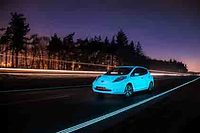BASF Rolls Out Glow-in-Dark Colors for Automotive Finishes
The colors, which offer aesthetic and safety appeal, were first shown on a Saleen S7R race car in June, the company said.
"Making colors visible at night introduces a whole new thinking," said Jon Hall, manager of Color Development for BASF's Automotive OEM Coatings Regional Business Unit. "Aesthetically, these new materials make the normal, beautiful colors visible on cars at night as they are during the day. And from a safety standpoint, this capability enables cars and trucks to be more readily seen when it's dark."
The Saleen S7R race car incorporated a "retroreflective pigment" in the BASF logos painted on the car. The pigment illuminates the coated surface when exposed to a light source in a similar technology to what is commonly seen in reflective clothing, street signs and safety markers. The effect of seeing color at night is achieved by combining the pigment's refractive index with a special reflective coating on one side of the pigment, Hall said. "When light hits this coating, such as from headlights from another automobile, it appears to light up or sparkle."
Another approach is the formulation of a coating that can glow in the dark and literally be turned off and on with a low-voltage electrical charge. This coating incorporates a proprietary "electroluminescent" pigment and an electrical field produced within the coating. The effect is produced with materials borrowed from BASF's Cosmetic Ingredients business.
BASF said it will continue to develop the Constellation Colors experimental coatings line and work with automotive manufacturers interested in making the concept in color and design a commercial reality.
Looking for a reprint of this article?
From high-res PDFs to custom plaques, order your copy today!




